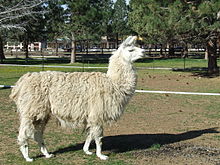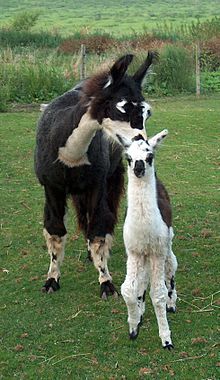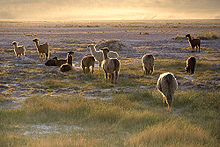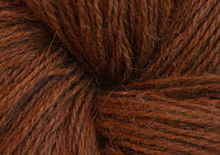- Llama
-
Llama 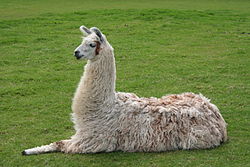
A llama lying down Conservation status DomesticatedScientific classification Kingdom: Animalia Phylum: Chordata Class: Mammalia Order: Artiodactyla Family: Camelidae Genus: Lama Species: L. glama Binomial name Lama glama
(Linnaeus, 1758)
Domestic llama range The llama (Lama glama) is a South American camelid, widely used as a meat and pack animal by Andean cultures since pre-Hispanic times.
The height of a full-grown, full-size llama is 1.7 to 1.8 m (5.5 to 6.0 ft) tall at the top of the head, and can weigh between 130 to 200 kilograms (280 to 450 lb). At birth, a baby llama (called a cria) can weigh between 9 and 14 kilograms (20 and 30 lb). Llamas can live for a period of about 20-30 years depending on how well they are taken care of.[citation needed] Llamas are very social animals and live with other llamas as a herd. The wool produced by a llama is very soft and lanolin-free. Llamas are intelligent and can learn simple tasks after a few repetitions. When using a pack, llamas can carry about 25% to 30% of their body weight for several miles.[1]
Llamas appear to have originated from the central plains of North America about 40 million years ago. They migrated to South America about 3 million years ago. By the end of the last ice age (10,000–12,000 years ago), camelids were extinct in North America.[1] As of 2007, there were over 7 million llamas and alpacas in South America and, due to importation from South America in the late 20th century, there are now over 158,000 llamas and 100,000 alpacas in the US and Canada.[2]
Contents
Classification
Although early writers compared llamas to sheep, their similarity to the camel was soon recognized. They were included in the genus Camelus along with alpaca in the Systema Naturae (1758) of Linnaeus.[3] They were, however, separated by Cuvier in 1800 under the name of llama along with the guanaco.[citation needed] Alpacas and vicuñas are in genus Vicugna. The genera Lama and Vicugna are, with the two species of true camels, the sole existing representatives of a very distinct section of the Artiodactyla or even-toed ungulates, called Tylopoda, or "bump-footed", from the peculiar bumps on the soles of their feet. The Tylopoda consists of a single family, the Camelidae, and shares the order Artiodactyla with the Suina (pigs), the Tragulina (chevrotains), the Pecora (ruminants), and the Cetancodonta (hippos and cetaceans, which belong to Artiodactyla from a cladistic, if not traditional, standpoint). The Tylopoda have more or less affinity to each of the sister taxa, standing in some respects in a middle position between them, sharing some characteristics from each, but in others showing special modifications not found in any of the other taxa.[citation needed]
The 19th century discoveries of a vast and previously unexpected extinct Tertiary fauna of North America, as interpreted by paleontologists Leidy, Cope, and Marsh, aided understanding of the early history of this family.[citation needed] Llamas were not always confined to South America; abundant llama-like remains were found in Pleistocene deposits in the Rocky Mountains and in Central America. Some of the fossil llamas were much larger than current forms. Some species remained in North America during the last ice ages. North American llamas are categorized as a single extinct genus, Hemiauchenia. Llama-like animals would have been a common sight 25,000 years ago, in modern-day California, Texas, New Mexico, Utah, Missouri, and Florida.[citation needed]
The camelid lineage has a good fossil record. Camel-like animals have been traced from the thoroughly differentiated, modern species back through early Miocene forms. Their characteristics became more general, and they lost those that distinguished them as camelids; hence, they were classified as ancestral artiodactyls.[citation needed] No fossils of these earlier forms have been found in the Old World, indicating that North America was the original home of camelids, and that Old World camels crossed over via the Bering Land Bridge. The formation of the Isthmus of Panama three million years ago allowed camelids to spread to South America as part of the Great American Interchange, where they evolved further. Meanwhile, North American camelids died out at the end of the Pleistocene.[4]
Characteristics
The following characteristics apply especially to llamas. Dentition of adults:-incisors 1/3 canines 1/1, premolars 2/2, molars 3/2; total 32. In the upper jaw, a compressed, sharp, pointed laniariform incisor near the hinder edge of the premaxilla is followed in the male at least by a moderate-sized, pointed, curved true canine in the anterior part of the maxilla. The isolated canine-like premolar which follows in the camels is not present. The teeth of the molar series which are in contact with each other consist of two very small premolars (the first almost rudimentary) and three broad molars, constructed generally like those of Camelus. In the lower jaw, the three incisors are long, spatulate, and procumbent; the outer ones are the smallest. Next to these is a curved, suberect canine, followed after an interval by an isolated minute and often deciduous simple conical premolar; then a contiguous series of one premolar and three molars, which differ from those of Camelus in having a small accessory column at the anterior outer edge.
 Names of llama body parts: 1 ears – 2 poll – 3 withers – 4 back – 5 hip – 6 croup – 7 base of tail – 8 tail – 9 buttock – 10 hock – 11 metatarsal gland – 12 heel – 13 cannon bone – 14 gaskin – 15 stifle joint – 16 flank – 17 barrel – 18 elbow – 19 pastern – 20 fetlock – 21 Knee – 22 Chest – 23 point of shoulder – 24 shoulder – 25 throat – 26 cheek or jowl – 27 muzzle
Names of llama body parts: 1 ears – 2 poll – 3 withers – 4 back – 5 hip – 6 croup – 7 base of tail – 8 tail – 9 buttock – 10 hock – 11 metatarsal gland – 12 heel – 13 cannon bone – 14 gaskin – 15 stifle joint – 16 flank – 17 barrel – 18 elbow – 19 pastern – 20 fetlock – 21 Knee – 22 Chest – 23 point of shoulder – 24 shoulder – 25 throat – 26 cheek or jowl – 27 muzzle
The skull generally resembles that of Camelus, the larger brain-cavity and orbits and less-developed cranial ridges being due to its smaller size. The nasal bones are shorter and broader, and are joined by the premaxilla.
Vertebrae:
- cervical 7,
- dorsal 12,
- lumbar 7,
- sacral 4,
- caudal 15 to 20.
The ears are rather long and slightly curved inward, characteristically known as "banana" shaped. There is no dorsal hump. The feet are narrow, the toes being more separated than in the camels, each having a distinct plantar pad. The tail is short, and fibre is long, woolly and soft.
In essential structural characteristics, as well as in general appearance and habits, all the animals of this genus very closely resemble each other, so whether they should be considered as belonging to one, two, or more species is a matter of controversy among naturalists.
The question is complicated by the circumstance of the great majority of individuals which have come under observation being either in a completely or partially domesticated state. Many are also descended from ancestors which have previously been domesticated, a state which tends to produce a certain amount of variation from the original type. The four forms commonly distinguished by the inhabitants of South America are recognized as distinct species, though with difficulties in defining their distinctive characteristics.
These are:
- the llama, Lama glama (Linnaeus);
- the alpaca, Vicugna pacos (Linnaeus);
- the guanaco (from the Quechua huanaco), Lama guanicoe (Müller); and
- the vicuña, Vicugna vicugna (Molina)
The llama and alpaca are only known in the domestic state, and are variable in size and of many colors, being often white, brown, or piebald. Some are grey or black. The guanaco and vicuña are wild, the former being endangered, and of a nearly uniform light-brown color, passing into white below. They certainly differ from each other, the vicuña being smaller, more slender in its proportions, and having a shorter head than the guanaco. The vicuña lives in herds on the bleak and elevated parts of the mountain range bordering the region of perpetual snow, amidst rocks and precipices, occurring in various suitable localities throughout Peru, in the southern part of Ecuador, and as far south as the middle of Bolivia. Its manners very much resemble those of the chamois of the European Alps; it is as vigilant, wild, and timid. The fiber is extremely delicate and soft, and highly valued for the purposes of weaving, but the quantity which each animal produces is minimal. Alpacas are descended from wild vicuna ancestors, while domesticated llamas are descended from wild guanaco ancestors, though a considerable amount of hybridization between the two species has occurred.
Differential characteristics between llamas and alpacas include the llama's larger size and longer head. Alpaca fiber is generally more expensive, but not always more valuable. Alpacas tend to have a more consistent color throughout the body. The most apparent visual difference between llamas and camels is that camels have a hump or humps and llamas do not.
Reproduction
Llamas have an unusual reproductive cycle for a large animal. Female llamas are induced ovulators. Through the act of mating, the female releases an egg and is often fertilized on the first attempt. Female llamas do not go into estrus ("heat").[5]
Like humans, llama males and females mature sexually at different rates. Females reach puberty at approximately 12 months old; males do not become sexually mature until approximately three years of age.[6]
Mating
Llamas mate with the female in a kush (lying down) position, which is fairly unusual in a large animal. They mate for an extended period of time (20–45 minutes), also unusual in a large animal.
Gestation
The gestation period of a llama is 11½ months (350 days). Dams (female llamas) do not lick off their babies, as they have an attached tongue which does not reach outside of the mouth more than half an inch (1.3 cm). Rather, they will nuzzle and hum to their newborns.[7]
Crias
A cria (from Spanish for "baby") is the name for a baby llama, alpaca, vicuña, or guanaco. Crias are typically born with all the females of the herd gathering around, in an attempt to protect against the male llamas and potential predators. Llamas give birth standing. Birth is usually quick and problem-free, over in less than 30 minutes. Most births take place between 8 a.m. and noon, during the warmer daylight hours. This may increase cria survival by reducing fatalities due to hypothermia during cold Andean nights. This birthing pattern is speculated to be a continuation of the birthing patterns observed in the wild. Crias are up and standing, walking and attempting to suckle within the first hour after birth.[8][9][10] Crias are partially fed with llama milk that is lower in fat and salt and higher in phosphorus and calcium than cow or goat milk. A female llama will only produce about 60 ml (2.1 imp fl oz) of milk at a time when she gives milk, so the cria must suckle frequently to receive the nutrients it requires.[11]
Breeding situations
In harem breeding, the male is left with females most of the year.
For field breeding, a female is turned out into a field with a male llama and left there for some period of time. This is the easiest method in terms of labor, but the least useful in terms of prediction of a likely birth date. An ultrasound test can be performed, and together with the exposure dates, a better idea of when the cria is expected can be determined.
Hand breeding is the most efficient method, but requires the most work on the part of the human involved. A male and female llama are put into the same pen and breeding is monitored. They are then separated and rebred every other day until one or the other refuses the breeding. Usually, one can get in two breedings using this method, though some studs have routinely refused to breed a female more than once. The separation presumably helps to keep the sperm count high for each breeding and also helps to keep the condition of the female llama's reproductive tract more sound. If the breeding is not successful within two to three weeks, the female is bred once again.
Pregnancy
Llamas should be tested for pregnancy after breeding at two to three, six and at least 12 weeks.
- For "spit" testing, bring the potentially pregnant dam to an intact male. If the stud attempts to mate with her and she lies down for him within a fairly short period of time, she is not pregnant. If she remains on her feet, spits, attacks him, or otherwise prevents his being able to mate, it is assumed she is probably pregnant. This test gets its name due to the dam spitting at the male if she is pregnant.
- For progesterone testing, a veterinarian can test a blood sample for progesterone. A high level can indicate a pregnancy.
- With palpation, the veterinarian or breeder manually feels inside the llama to detect a pregnancy. There are some risks to the llama, but it can be an accurate method for pregnancy detection.
- Ultrasound is the most accurate method for an experienced veterinarian, who can do an exterior examination and detect a fetus as early as 45 days.
Spit testing with an intact male is generally free and is usually accurate. However, some hormonal conditions in females can make them reject a male when they are in fact not pregnant, and, more rarely, accept a male when they are pregnant. Progesterone tests can give a high reading in some females with a hormonal problem which are in fact not pregnant. Neither of the previous methods, nor palpation, can give a reasonably accurate idea of the age of the fetus, while an ultrasound procedure can. In addition, an ultrasound procedure can distinguish between pregnancy and misleading physical conditions, or between a live and dead fetus. The disadvantages of an ultrasound procedure are cost, some training in the use of ultrasound equipment is required, and not all veterinarians have the equipment needed to perform the examination.
Nutrition
Options for feeding llamas are quite wide; a wide variety of commercial and farm-based feeds are available. The major determining factors include feed cost, availability, nutrient balance and energy density required. Young, actively growing llamas require a greater concentration of nutrients than mature animals because of their smaller digestive tract capacities.[12]
Estimated daily requirements[clarification needed (what units?)] of bromgrass hay, alfalfa hay and corn silage on an as-fed and 100% dry matter basis for llamas from 22 to 550 pounds.[13] Body weight
(lb)Bromgrass Alfalfa Corn silage (as fed) (dry matter) (as fed) (dry matter) (as fed) (dry matter) 22 0.8 0.7 0.5 0.5 1.5 0.4 44 1.3 1.1 0.9 0.8 2.6 0.7 88 2.1 1.9 1.5 1.3 4.3 1.2 110 2.6 2.3 1.7 1.6 5.2 1.4 165 3.4 3.1 2.3 2.1 6.9 1.9 275 5.0 4.5 3.4 3.1 10.1 2.8 385 6.4 5.7 4.3 3.9 12.9 3.6 495 7.8 7.0 5.3 4.8 15.8 4.4 550 8.5 7.6 5.7 5.2 17.0 4.8 Behavior
Llamas which are well-socialized and trained to halter and lead after weaning are very friendly and pleasant to be around. They are extremely curious and most will approach people easily. However, llamas that are bottle-fed or over-socialized and over-handled as youngsters will become extremely difficult to handle when mature, when they will begin to treat humans as they treat each other, which is characterized by bouts of spitting, kicking and neck wrestling. Anyone having to bottle-feed a cria should keep contact to a minimum and stop as soon as possible.
When correctly reared, llamas spitting at a human is a rare thing. Llamas are very social herd animals, however, and do sometimes spit at each other as a way of disciplining lower-ranked llamas in the herd. A llama's social rank in a herd is never static. They can always move up or down in the social ladder by picking small fights. This is usually done between males to see which will become dominant. Their fights are visually dramatic, with spitting, ramming each other with their chests, neck wrestling and kicking, mainly to knock the other off balance. The females are usually only seen spitting as a means of controlling other herd members.
While the social structure might always be changing, they live as a family and they do take care of each other. If one notices a strange noise or feels threatened, a warning bray is sent out and all others come to alert. They will often hum to each other as a form of communication.
The sound of the llama making groaning noises or going "mwa" is often a sign of fear or anger. If a llama is agitated, it will lay its ears back. One may determine how agitated the llama is by the materials in the spit. The more irritated the llama is, the further back into each of the three stomach compartments it will try to draw materials from for its spit.
An "orgle" is the mating sound of a llama or alpaca, made by the sexually aroused male. The sound is reminiscent of gargling, but with a more forceful, buzzing edge. Males begin the sound when they become aroused and continue throughout the act of procreation—from 15 minutes to more than an hour.[14][15]
Guard behavior
Using llamas as livestock guards in North America began in the early 1980s, and some sheep producers have used llamas successfully since then.[16][17] They are used most commonly in the in western regions of the US, where larger predators, such as the coyote, are prevalent. Typically, a single gelding (castrated male) is used.
Research suggests the use of multiple guard llamas is not as effective as one. Multiple males tend to bond with one another, rather than with the livestock, and may ignore the flock. A gelded male of two years of age bonds closely with its new charges and is instinctively very effective in preventing predation. Some llamas appear to bond more quickly to sheep or goats if they are introduced just prior to lambing. Many sheep and goat producers indicate a special bond quickly develops between lambs and their guard llama and the llama is particularly protective of the lambs.
Using llamas as guards has eliminated the losses to predators for many producers. The value of the livestock saved each year more than exceeds the purchase cost and annual maintenance of a llama. Although not every llama is suited to the job, most are a viable, nonlethal alternative for reducing predation, requiring no training and little care.[18]
History
Pre-Incan cultures
The Moche people frequently placed llamas and llama parts in the burials of important people, as offerings or provisions for the afterlife.[19] The Moche culture of pre-Columbian Peru depicted llamas quite realistically in their ceramics.
Inca empire
In the Inca empire, llamas were the only beasts of burden, and many of the peoples dominated by the Inca had long traditions of llama herding. For the Inca nobility, the llama was of symbolic significance, and llama figures were often buried with the dead.[20] In South America, llamas are still used as beasts of burden, as well as for the production of fiber and meat.[21]
The Inca deity Urcuchillay was depicted in the form of a multicolored llama.[22]
Scholar Alex Chepstow-Lusty has argued that the switch from a hunter-gatherer lifestyle to widespread agriculture was only possible because of the use of llama dung as fertilizer.[23]
Spanish empire
One of the main uses for llamas at the time of the Spanish conquest was to bring down ore from the mines in the mountains.[24] Gregory de Bolivar estimated that in his day, as many as 300 thousand were employed in the transport of produce from the Potosí mines alone, but since the introduction of horses, mules, and donkeys, the importance of the llama as a beast of burden has greatly diminished.[25]
According to Juan Ignacio Molina, the Dutch captain Joris van Spilbergen observed the use of chiliquenes (a llama type) by native Mapuches of Mocha Island as plow animals in 1614.[26]
Fiber
Llamas have a fine undercoat which can be used for handicrafts and garments. The coarser outer guard hair is used for rugs, wall-hangings and lead ropes. The fiber comes in many different colors ranging from white or grey to reddish-brown, brown, dark brown and black.
Average diameter of some of the finest, natural fibers[27] Animal Fiber diameter
(micrometres)Vicuña 6–10 Alpaca (Suri) 10–15 Muskox (Qivlut) 11–13 Merino 12–20 Angora Rabbit 13 Cashmere 15–19 Yak Down 15–19 Camel Down 16–25 Guanaco 16–18 Llama (Tapada) 20–30 Chinchilla 21 Mohair 25–45 Alpaca (Huacaya) 27.7 Llama (Ccara) 30–40 See also
- Alpaca
- Cama, a crossbreed between a llama and a camel
- Grass Mud Horse, a parody originating from Mainland China of 2009 that features the alpaca and llama
- Guard llama, llamas used as livestock guardians
- Lamoid
- Llama hiking
References
 This article incorporates text from a publication now in the public domain: Chisholm, Hugh, ed (1911). "Llama". Encyclopædia Britannica (11th ed.). Cambridge University Press.
This article incorporates text from a publication now in the public domain: Chisholm, Hugh, ed (1911). "Llama". Encyclopædia Britannica (11th ed.). Cambridge University Press.
- ^ a b "Llama". Oklahoma State University. 2007-06-25. http://www.ansi.okstate.edu/breeds/other/llama/.
- ^ South Central Llama Association (2009-01-22). "Llama Facts". http://www.scla.us/llamafacts.html.
- ^ Murray E. Fowler (1998). Medicine and Surgery of South American Camelids. Wiley-Blackwell. p. 1. ISBN 0813803977. http://books.google.com/books?id=zb9zbY-JfBUC&printsec=frontcover.
- ^ Grayson, Donald K. (1991). "Late Pleistocene mammalian extinctions in North America: Taxonomy, chronology, and explanations". Journal of World Prehistory (Springer Netherlands) 5 (3): 193–231. doi:10.1007/BF00974990.
- ^ Greta Stamberg and Derek Wilson (2007-04-12). "Induced Ovulation". Llamapaedia. http://www.llamapaedia.com/reproduction/ovulate.html.
- ^ L. W. Johnson (2007-04-17). "Llama reproduction". College of Veterinary Medicine and Biomedical Sciences, Colorado State University, Fort Collins.. National Library of Medicine and the National Institutes of Health. http://www.ncbi.nlm.nih.gov/entrez/query.fcgi?cmd=Retrieve&db=PubMed&list_uids=2647232&dopt=Citation.
- ^ "The llama reproductive cycle". LlamaWeb. 2007-04-17. http://www.llamaweb.com/about/reproduction.html.
- ^ The Department of Veterninary Clinical Sciences at Ohio State University (2002). Camelid Medicine, Surgery, and Reproduction for Veterinarians. Part II.
- ^ Long, Patrick O. (1996). Llama & Alpaca Neonatal Care. p. 112. ISBN 0964661837.
- ^ Birutta, Gale (1997). A Guide to Raising Llamas. p. 327. ISBN 0882669540.
- ^ Linda March. "Llamas: A Different Kind of Pet". University of Illinois, College of Veterinary Medicine. http://vetmed.illinois.edu/petcolumns/showarticle.cfm?id=222. Retrieved 2009-05-15.[dead link]
- ^ Randy Sell (2007-04-17). "Llama". Department of Agricultural Economics, North Dakota State University. http://www.ag.ndsu.edu/pubs/alt-ag/llama.htm.
- ^ Murray E. Fowler, DVM (1989). Medicine and Surgery of South American Camelids; Llama, Alpaca, Vicuña, Guanaco. Iowa State University Press.
- ^ Greta Stamberg and Derek Wilson (1997-09-02). "Behavior: Sounds". Llamapedia. http://www.llamapaedia.com/behavior/sounds.html.
- ^ Brian and Jane Pinkerton (2008-05-17). "Llama Sounds". Humm Page. http://personal.smartt.com/~brianp/allsounds.html.
- ^ International Llama Association. (1995). "Guard Llamas." ILA Educational Brochure #2.
- ^ Walker, Cameron. "Guard Llamas Keep Sheep Safe From Coyotes." National Geographic, June 10, 2003.
- ^ "Guard Llamas: An Alternative for Effective Predator Management". http://www.whyllama.com/GuardLlamas.htm#Guarding%20behavior/.
- ^ Berrin, Katherine & Larco Museum. The Spirit of Ancient Peru:Treasures from the Museo Arqueológico Rafael Larco Herrera. New York: Thames & Hudson, 1997 ISBN 0500018022.
- ^ "Little Llamas". Inca culture. 2006-10-10. http://www.nationalgeographic.com/inca/inca_culture_4.html.
- ^ "Information Resources on the South American Camelids: Llamas, Alpacas, Guanacos, and Vicunas 1943–2006". 2007-06-25. http://www.nal.usda.gov/awic/pubs/llama.htm.
- ^ D'Altroy, Terence N. (2002). "The Inca Pantheon". The Incas. The Peoples of America. Oxford: Blackwell Publishing. p. 149. ISBN 9780631176770.
- ^ Anning, Caroline. (2011-05-22) BBC News – Inca success in Peruvian Andes 'thanks to llama dung'. Bbc.co.uk. Retrieved on 2011-08-21.
- ^ Jared Diamond (2007-04-12). "Guns, Germs & Steel. The Show: Episode Two". PBS. http://www.pbs.org/gunsgermssteel/show/episode2.html.
- ^ Jared Diamond (2007-04-12). "Guns, Germs & Steel. The story of ... Llamas". PBS. http://www.pbs.org/gunsgermssteel/variables/llamas.html.
- ^ Juan Bautista Ignacio Molina (1808). The geographical, natural and civil history of Chili, tr. by an American gentleman. pp. 15–16. http://books.google.com/books?id=F4oIAAAAQAAJ&pg=PA15. Retrieved 22 August 2011.
- ^ Beula Williams (2007-04-17). "Llama Fiber". International Llama Association. http://www.llama.org/llama_fiber.htm.
External links
- "Llamapaedia Orgle Sound" (AIFF). http://www.llamapaedia.com/gifs/orgle.aiff.
- Llamas Close Up – slideshow by Life magazine
Afro-Asiatic Camelids South American Camelids Hybrid Fibers Natural Mineral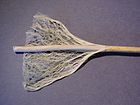
Synthetic CelluloseMineral
Wikimedia Foundation. 2010.


